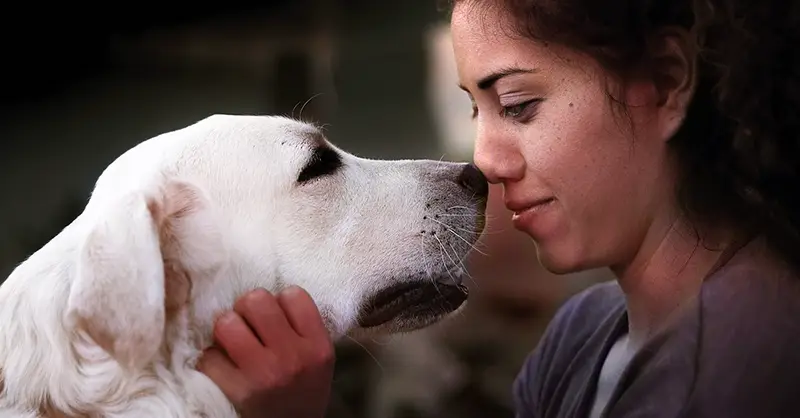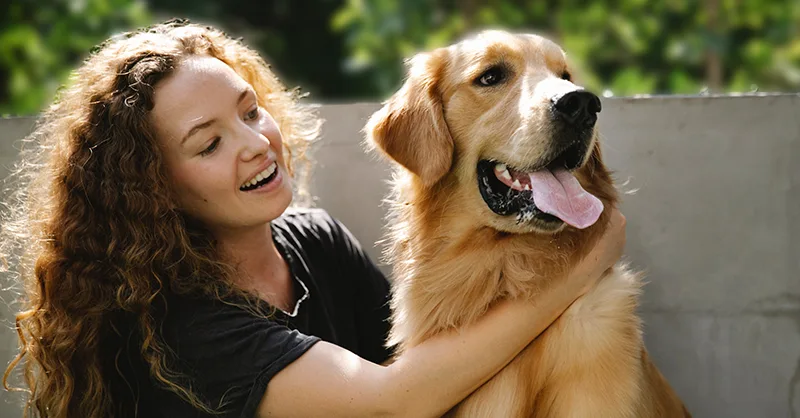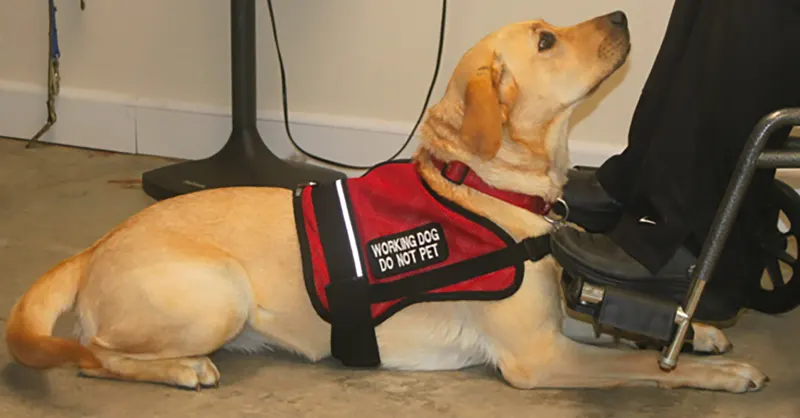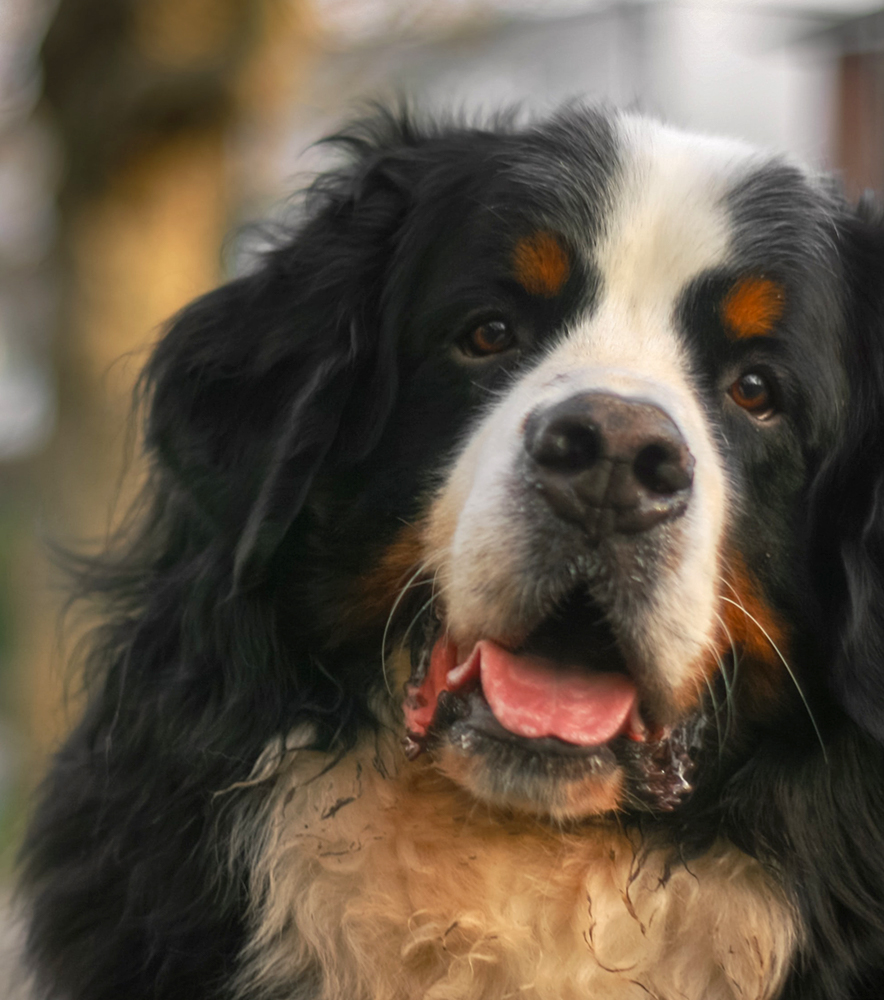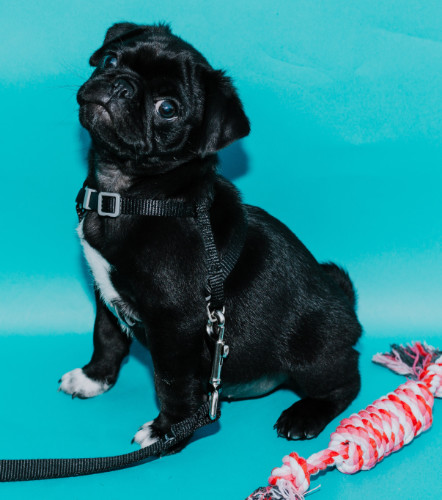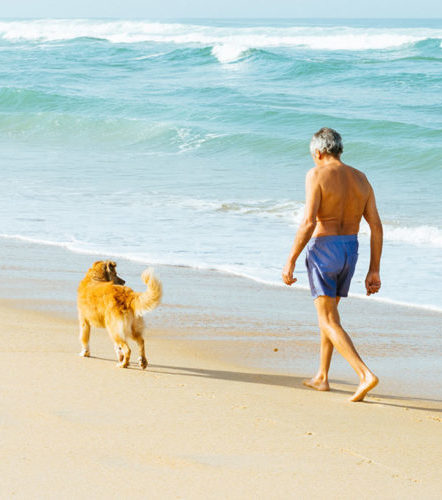Archive for the ‘Dogs’ Category
Mobility service dogs do more than help a person with a disability walk or remain upright. They can receive training to perform a variety of tasks related to movement. For instance, they can:
Move obstacles out of a disabled person’s path (such as rugs, chairs, or small objects). Obtain items that are out of reach for a person. Retrieve items that fall onto the floor. Hold coats and jackets to help their owner dress or undress. Function as a brace for people who struggle with strength or balance issues. Bark to alert others when their owner falls or collapses.To register your dog as a service dog in our national database, click on the link below to get started.
Five Best Mobility Dog BreedsMobility dogs must be intelligent, as with all service dogs, but they also have to be an adequate size to qualify as a true mobility service dog. Because people with mobility issues may fall or require a brace, small dogs may not be appropriate. Mobility dogs are often strong and solid dogs, squarely built and full of muscle. They must also have a patient temperament, free from anxiety.
The following dogs are the five best mobility dog breeds for people with disabilities:
Labrador RetrieversLabrador Retrievers are a favorite choice for most types of service dog requirements. They’re highly intelligent and eager to please, but labrador retrievers also have an excellent temperament. They bond well with their owners and family, are calm in public spaces, and socialize well with other dogs. It’s their size, however, that makes them an optimal mobility service dogs. They’re strong and sturdy, and grow large enough to help brace their owners and life limbs. Male Labrador retrievers can grow up to 80 pounds and can reach two feet in height.
The intelligent Labrador Retriever is all around a perfect mobility service dog. NewfoundlandsNewfoundland dogs are very large dogs, making them ideal for taller individuals who require fall prevention or bracing. The male dogs can grow up to 150 pounds and 28 inches in height. Although they’re large dogs, Newfoundlands are exceptionally gentle and patient. They’re well known in the dog world for being sweet and attentive with their owners—precisely what mobility service dog owners need.
Newfoundlands are gentle giants that can support larger humans. Bernese Mountain DogsThe Bernese Mountain Dog looks almost like a large fluffy teddy bear, and their temperament adds to this aura. Their broad head and thick fur are adorable, but these traits also make the Bernese Mountain Dog great mobility dogs. Their thick coat allows their owners to grab onto them or brace themselves comfortable—and their large heads can do the same. This breed also boasts a gentle and patient personality. Not prone to anxiety or fear, they are well-behaved when out in public. Adult male Bernese Mountain dogs can reach up to 115 pounds and 27 inches in height, which allows them to tolerate weight.
Bernese Mountain Dogs has the size and temperament to be excellent mobility dogs. RottweilersRottweilers are well-known as guard dogs, but they also make ideal mobility service dog. Their size and physique make for a sturdy brace, and they can tolerate and pull weight. Male Rottweilers can grow up to 135 pounds and grow to 27 inches in height. What’s more, Rottweilers are exceptionally easy to train and loyal to their owners. Although their reputation as vicious guard dogs precede them, they’re quite calm and gentle. When in a playful mood, they can also be silly and goofy!
With their strength and loyalty Rottweilers make great mobility service dogs. St. BernardThe St. Bernard is a large dog. Owners who choose a St. Bernard as a service dog may want to consider their size. Not only is the St. Bernard a huge dog, but it’s also very furry—making it look even larger. A male St. Bernard can grow up to 180 pounds and 30 inches in height. Ideal for larger people who may require a brace for fall prevention, the St. Bernard is an excellent mobility service dog. This breed, especially the males, are solid and muscular underneath the layers of fur. They’re also calm, attentive, and eager to learn. Despite their size, they’re wonderful with small children and function well in families.
The St. Bernard is a gentle, strong giant and eager to work as a mobility service dog. Other Points to Consider with Mobility Dog BreedsDogs used as mobility service dogs tend to be larger breeds. And large breeds need more space and more food. A mobility service dog works well in larger areas with little clutter. These dogs also need to stay fit to do their work, requiring space to run and play in. And because they’re often working, they may need extra nourishment.
Large dogs may also require costly grooming fees because of their size and fur. This point is important because adequate grooming and feeding keep service dogs healthy and ready to accomplish their tasks. If you’re looking for a mobility service dog and can provide the right environment and care, then the breeds above may be right for you!
Dogs can’t tell the difference between a luxury dog toy and a dollar store dog toy. All they know is that it’s given with love and that it’s theirs. The following are ten simple dog toy ideas that will give your service dog hours of stimulation without breaking the bank!
Show everyone that the rights of your service dog should be respected. Get your service dog registered below.
Bouncy SockThis DIY is a great way to use those socks who have lost their other half. It also satisfies your dog’s needs to run around with your socks—except this one is clean.
What You Need: – One tennis ball– One sock
Instructions: Push a tennis ball into a sock. Make sure the tennis ball gets all the way to the toe area. Knot the sock near the tennis ball area. Throw the sock ball and watch your dog enjoy the bouncing sock.
Food FinderDogs love food, and they also love a challenge. Hiding snacks in a tennis ball turns it into a fun snack dispenser.
What You Need: – One tennis ball– Doggy snacks– A knife or box cutter
Instructions: Choose a seam on the tennis ball and cut a small slit along the seam. Stuff the dog snacks into the slit. Throw the ball towards your dog and let the fun begin.
A tennis ball and food can make a great DYI toy for your service dog. Treat BottleWhat You Need:– One empty plastic bottle– Doggy snacks – Denim strips
Instructions: Unscrew the lid from the bottle’s neck and discard the lid. Push the dog treats and denim into the bottle. Watch your dog puzzle over this delicious toy.
Chew Toy from DenimWhat You Need: – Old denim jeans– Scissors
Instructions: For this project, make sure to use thick denim. Don’t use stretch denim or chambray cloth, or your dog will tear the toy to shreds in no time. Cut the denim into long strips. Gather the trips together and knot one end very tightly. Then braid the pieces together. Knot at the other end when complete. When done, you should have a braided chew toy that will occupy your dog for hours.
Iceberg TreatsWhat You Need: – Small dog toys– A plastic bowl or container– Water – Your freezer
Instructions: Take your dog’s favorite small dog toys, place them in the container. Then add water into the container and fill it to the top. Once the container is filled, freeze the container overnight. When the contents are fully frozen, slide the entire amount out. It’s best to do this treat outside in warm weather for a cool summer day treat. Note: If you feel exceptionally creative, you can use broth to freeze the toys instead of water. You can also freeze fruit pieces or dog treats!
Floppy Stuffed AnimalWhat You Need: – A clean stuffed animal– Scissors– Needle and thread– Fabric strips (optional)
Instructions: If you have an old stuffed animal lying around, you’ve got yourself a dog toy. Simply remove the stuffing and sew the (un-stuffed) animal back up. You’ve got a floppy toy for your dog! If you’re feeling extra adventurous, stuff the animal halfway with thick fabric strips for an extra treat when your dog finally chews it open. Just be aware of the confetti-like celebration your dog will leave in their wake!
An old stuffed animal can be turned into a great DYI. Frozen HandWhat You Need: – A clean old, thick glove– Broth or water– Dog treats – Your freezer
Instructions: Place the dog treats at the end of each finger, and knot the fingers of the glove. The knot prevents the treats from slipping out. Soak the glove in broth and freeze. Give to your dog after it’s frozen. Just like the Iceberg treats, this is a perfect sunny day toy for a dog.
Simple Peanut JarWhat You Need: – A plastic jar– Peanut butter
Instructions:This dog toy DIY is simplest when you’re at the end of a peanut butter jar. Instead of scraping the sides clean, just hand it over to the dog to do the dirty work. If you don’t have an almost empty peanut butter jar, any durable plastic jar will do. You can smear peanut butter onto the insides of the jar. If you’d like, you can mix in crumbled doggy treats into the peanut butter. Freezing the jar and peanut butter also gives an extra treat for those warm days.
The Rope ThrowWhat You Need: – A piece of old rope– One tennis ball
Instructions: You can cut or drill a hole in each side of the ball. Make the holes large enough to slide the piece of rope through. Slide the ball into the middle of the rope. Form tight knots on either side of the ball to keep the ball in place. This creates a toy to play fetch with.
Dog FeederWhat You Need: – One foot PVC pipe– 2 PVC pipe caps– Doggy treats
Instructions:This DIY takes a little for elbow grease than the others, but it’s worth the effort. Mainly for large dogs, this PVC pipe dog feeder will last through multiple playtimes. Carefully drill holes throughout the pipe. Sand the rough edges of the holes down with the sandpaper. Wash the pipe with soap and water and let dry. When dry, insert the dog treats and cap the ends. Your dog will love trying to get the treats out of this simple and sturdy toy!
Keep Your Dog SafeFor all of these DIY toys, as with any dog toy, supervise your dog when they’re playing. Make sure that the dog toys and snacks are the appropriate sizes for your dog. Have fun making these doggy diversions. Your dog will thank you for them!
Many seniors find Service Dogs helpful in maintaining their independence while dealing with mobility challenges. Fortunately, Service Dogs are able to travel with their owners wherever they go.
In order to certify your dog as a service dog, you will need to train the animal to provide a task to help with your disability. Although it is not required, you may also submit your dog’s information to get your ID and service dog certification online and enroll it in a national database that is easily searchable.
While most breeds can be trained as a Service Dog, you will want one that can meet the physical demands of the job. In this article you can find some of the more popular breeds for Service Dogs that work best for seniors.
To register your dog as a service dog in our national database, click on the link below to get started.
RetrieversBoth Golden and Labrador Retrievers are common choices for Service Dogs. Gentle by nature, Golden Retrievers are popular with families that have young children, but they are also excellent companions for seniors with mobility issues. Goldens are very intelligent and easily trained. In addition to their other wonderful traits, they are large and strong enough to provide physical support for a person with mobility challenges. For example, they are good at carrying things—as their name suggests—and can help provide support for a person who has balance issues or difficulty standing.
Golden Retrievers make all-around perfect Service Dogs.Labradors are also very intelligent, and have sharp hearing and a strong sense of smell. Like Goldens, they are easy to train, with friendly personalities and a strong desire to please. They also have the strength to assist with a wide variety of physical tasks.
Poodles The friendly Poodle will not disappoint.Poodles are usually medium-sized dogs, and are able to perform several tasks, such as carry objects, fetch things, turn lights on and off, and open and close doors. They are also known for their ability to sniff out allergens in food, so if you have a severe food allergy, they can be an excellent choice. Also friendly by nature, Poodles are easy to train.
German Shepherds German Shepherds are strong and guide you safely through life.Like Retrievers, Shepherds are large dogs that do well at physical tasks like providing support and helping people get around. However, they test well in all Service Dog categories, and make excellent guide dogs for the visually impaired. They can help you move safely through your home and the outside world, as well as give you extra support if you need assistance with standing, walking, or other movements.
PomeraniansPomeranians are a smaller breed, and not as well suited for a person who needs a lot of physical support. Some people think they are too small to be Service Dogs, but this is a common misconception. They make excellent medical alert dogs for people who may have sudden changes in condition—such as people with diabetes, heart conditions, epilepsy or other neurological issues. For example, they can let you know if your blood sugar has fallen too low, so you can eat something or seek medical attention.
The small Pomeranian is your nurse on four paws.Pomeranians are also great for people with hearing impairments. They can be trained to alert you to sounds you wouldn’t otherwise notice, like a knock at the door, a ringing doorbell or phone, etc.
Bernese Mountain Dogs The strong, kind Bernese Mountain Dog can take on any task.This is another large breed suitable to be a Service Dog for owners with physical support needs. In training, they have to prove they can support the weight of their owner and pull a wheelchair in order to be of assistance. Friendly and intelligent, Bernese Mountain Dogs are capable of a variety of other tasks, including picking up items and even opening the door for emergency services personnel if you have an emergency and need help.
ColliesMany of us have seen reruns of that old TV show about the Collie “Lassie” who was always running for help when her young human friend was in trouble. As it turns out, Collies really are very intelligent, and great at caring for their human companions. They are large enough to help with physical tasks, but are also known for their ability to detect seizures in advance. If you have epilepsy, a Collie may be trained to let you know before a seizure starts, so you can call for help, take medication, or make sure you aren’t in an unsafe place (like a bathtub).
The Collie is your smart companion.Collies are also great at providing emotional support for patients with mental health issues like anxiety and PTSD. However, as a long-haired breed, they do shed sometimes, so you will want to find a good vacuum cleaner for picking up dog hair.
If you are ready to take your Service Dog with you after you’ve gone through proper training, you may considered ordering your Service Dog a vest and ID card and registering their information into Service Dog Certifications’ global database. For more information, click on the image below.
